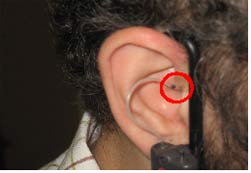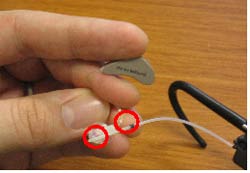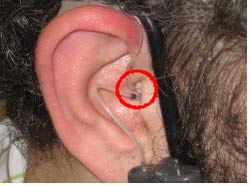Question
What factors do I need to take into consideration when performing real ear measures on Receiver-In-the-Ear and thin tube open products?
Answer
Should I expect to see any measurable differences in the Real Ear verification of Receiver-In-the-Ear open products and thin tube open products?
Typically for open fittings, the measured responses for devices with a receiver located in the ear canal are very similar to those with the receiver located in the Behind-The-Ear component of the instrument. (Hallenbeck, Groth, 2008) Subtle differences in the "smoothness" of the frequency response may be observed between the two products due to the presence of tube resonances inherent in thin tube products, however many of these differences are already accounted for in the manufacturer's electroacoustic specifications. Differences between products may manifest themselves in terms of frequency response, but these differences are not related to receiver placement alone.
What are the acoustic implications of running real ear verification in an open fit?
It is important to keep in mind that when using real ear measurements to verify open fittings, regardless of receiver placement, several adjustments to a standard protocol may be necessary to account for the acoustic implications of an open fit. First, it is possible for an outflow of amplification from the open ear canal to reach the reference microphone of the real ear probe. Therefore, the reference microphone receives a combined signal of the test stimulus from the test speaker, and the outflow of amplification from the ear canal. This combined signal may be registered by the test equipment as more intense than the calibrated signal and will reduce the test stimulus accordingly. Because the real ear equipment derives insertion gain by subtracting the input level and the unaided gain from the aided response, this will then result in a higher input level being subtracted than what actually was produced by the test speaker. Thus, the resultant insertion gain indicated by the real ear equipment may be less than what is actually present in the ear canal. Several real ear modules have implemented factory presets to automatically account for this outflow and the clinician need do nothing more than select "open" when verifying an open product. The procedure for "open" will then include an equalization measure with the probe mounted on the patient, and the test signal will be adjusted correspondingly. If a real ear measurement system implemented in a clinic does not have any automated presets, the affect of this outflow may be limited if the reference microphone can be turned off, or if the space between the reference microphone and the hearing aid is increased. It should also be noted that this phenomenon is unlikely to occur except in the case of high gain open fittings (i.e. high frequency insertion gain of 25 dB or more).
Can you expect to get low frequency gain in an open fit?
Questions have surfaced regarding the availability of low frequency gain in open fit hearing aids. Many open fit hearing aids are capable of providing low frequency gain in a closed cavity such as coupler, while others employ a high pass filter which significantly limits gain below the filter's corner frequency. Regardless, no open fit hearing instruments currently available are capable of building up low frequency sound pressure in the open ear canal due to the small size of the receivers utilized. Real ear gain at 500 Hz and below should not be expected for open fittings.
An interesting phenomenon which may be visible at frequencies where the output from the hearing aid is similar in amplitude to the direct sound to the ear canal is the interaction between the sounds from these two pathways. Because the amplified sound is somewhat delayed by the hearing aid processing, amplified sound and direct sound (resulting from the open fit) will be out of phase as they mix in the ear canal. As a result, summation and cancellation effects may be observed in the low frequency region up to about 1500 Hz (Mueller, Ricketts, 2006). These effects manifest themselves as a bumpy rather than smooth curve on the real ear equipment display and may give the impression that there is low frequency real ear gain. While strange in appearance, these effects are not perceptually disturbing nor do they indicate that any useful low frequency gain is present.
Should sound processing algorithms be disabled prior to running real ear measurements?
When making comparative insertion gain measures between products, it is always important to ensure a level playing field. Accordingly, it is recommended to always deactivate all sound processing algorithms including noise reduction, feedback cancellation, compression systems, and directionality. Also, several test stimuli are available when making these comparisons. Extensive literature, including ANSI standards, has been published highlighting the pros, cons and general stimulus effects of these options on real ear measurements. While the optimal stimulus is largely based on the desired investigation, it is paramount to use the same stimulus when comparing products.
Does Probe Tube placement affect the frequency response?
Real Ear measurements are very susceptible to error based on probe tube placement. When comparing devices it is very important to maintain probe tube depth between the two measurements as subtle changes in placement can offset measurements greatly, especially in the high frequencies. Probe tube placement can be controlled using the marker on the probe tube and the receiver wire or thin tube. Simply place the probe tube in the ear canal and ensure an accurate REUG measurement. Because open fittings are focused on providing high frequency gain with bandwidth sometimes extending beyond 5000 Hz, sufficient probe tube insertion depth is important. The probe tube must be placed deep enough that the REUG at 6 kHz does not dip below -5 dB. If this condition is not fulfilled, you may see a misleadingly large peak in the insertion gain near this frequency. Set the marker near the superior aspects of the tragus. Insert the tube through the openings of the ear dome and match the marker to bend at which the wire or tube enters the ear canal. This technique should reduce placement variability and maximize patient comfort.



References:
Hallenbeck S, Groth J. (2008). Thin tube and receiver-in-canal devices: There is positive feedback on both! Hearing Journal 61(1):28-34.
Mueller HG, Ricketts T (2006).Open-canal fittings: Ten Take-home tips. Hearing Journal 59(11):24-39.
Stephen A. Hallenbeck, Au.D. is a Research Audiologist with GN ReSound in the department of Research and Development. Prior to joining GN ReSound, he provided clinical audiologic services including audiometric testing, electrophysiological evaluations, balance assessment, hearing conservation services, hearing aid evaluations and hearing aid fittings in hospital and private audiologic practice settings. Stephen earned his Doctor of Audiology degree from Rush University in Chicago. He is an active member of the Illinois Academy of Audiology and the American Academy of Audiology.

